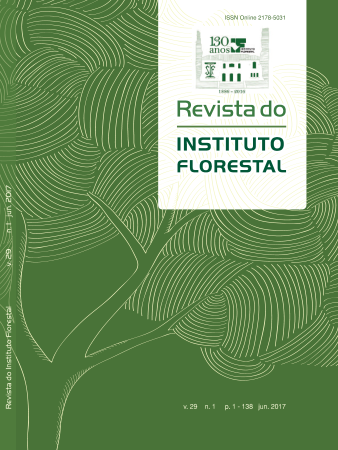RICHNESS, RELEVANCE AND CONSERVATION STRATEGIES FOR SAVANNA GRASSLANDS IN THE HORTO FLORESTAL OF BOTUCATU, SP, BRAZIL
DOI:
https://doi.org/10.24278/2178-5031.201729102Keywords:
wet grassland, dry grassland, life forms, floristic surveyAbstract
Tropical grassy biomes and the small plants forming the ground layer have been rarely assessed in the entire world. Unknown, they have been globally neglected by science and conservation policies. Aiming at filling this gap, we assessed the plant species composition and the biological spectrum of dry and wet grasslands within a small remnant of Cerrado vegetation, in Botucatu, SP, Brazil. We recorded 210 species, from which 61% are herbs, 17% shrubs and 17% subshrubs. Woody species represent just 6% of the total richness. Only 12 species occurred in both physiognomies, an evidence of high habitat specificity (high beta diversity). Species richness and diversity of life forms were higher in the dry environments, while the number of families was higher in the wet grassland. Among the observed species, six are under risk of extinction in SP state or in the whole country: Evolvulus fuscus Meisn., Curtia tenuifolia (Aubl.) Knobl., Camarea hirsuta A.St-Hil., Andropogon hypogynus Hack., Richardia stellaris (Cham. & Schltdl.) Steud. and Xyris brevifolia Michx. In spite of the small size of this area (33.88 ha) and the pressures due to the proximity to the urban zone, it still preserves high biodiversity. Therefore, these results strengthen the importance of this rare remnant of grassland vegetation in São Paulo state for conservation of Cerrado biodiversity and support its categorization as an Ecological Station.
Downloads
References
ABREU, R.C.; DURIGAN, G. Changes in the plant community of a Brazilian grassland savannah after 22 years of invasion by Pinus elliottii Engelm. Plant Ecology & Diversity, v. 4, p. 269-278, 2011.
ALVARES, C.A. et al. Köppen’s climate classification map for Brazil. Meteorologische Zeitschrift, v. 22, n. 6, p. 711-728, 2013.
BRASIL. Ministério do Meio Ambiente. SNUC – Sistema Nacional de Unidades de Conservação da Natureza: Lei nº 9.985, de 18 de julho de 2000; Decreto nº 4.340, de 22 de agosto de 2002; Decreto nº 5.746, de 5 de abril de 2006. Plano Estratégico Nacional de Áreas Protegidas: Decreto nº 5.758, de 13 de abril de 2006. Brasília, DF: MMA, 2011. 76 p.
______. Lei nº 12.651, de 25 de maio de 2012. Dispõe sobre a proteção da vegetação nativa. Diário Oficial da República Federativa do Brasil, v. 25, p. 1, 2012.
CARVALHO, G. Flora: tools for interacting with the Brazilian flora 2020. R package version 0.2.7.2006. Disponível em: http://www.github.com/gustavobio/flora>. Acesso em: 11 mar. 2016.
COUTINHO, L.M. Fire in the ecology of the Brazilian cerrado. In: GOLDAMMER, J.G. (Ed.). Fire in the tropical biota. Berlin: Springer Berlin Heidelberg, 1990. p. 82-105.
FLORA do Brasil 2020 em construção. Jardim Botânico do Rio de Janeiro. Disponível em: <http://floradobrasil.jbrj.gov.br/>. Acesso em: 14 mar. 2016. DEPARTAMENTO DE ÁGUAS E ENERGIA ELÉTRICA DO ESTADO DE SÃO PAULO – DAEE. Disponível em: <http://www.daee.sp.gov.br/>. Acesso em: 11 mar. 2016.
DURIGAN, G. et al. Plantas do cerrado paulista –imagens de uma paisagem ameaçada. São Paulo: Páginas & Letras, 2004. 475 p.
______.; RATTER, J.A. Successional changes in cerrado and cerrado/forest ecotonal vegetation in western São Paulo State, Brazil, 1962-2000. Edinburgh Journal of Botany, v. 63,n. 1, p. 119-130, 2006.
GRIME, J. PHILIP. Plant strategies, vegetation processes, and ecosystem properties. Chichester: John Wiley & Sons, 2006. 419 p.
INSTITUTO BRASILEIRO DE GEOGRAFIA E ESTATÍSTICA – IBGE. Manual técnico da vegetação brasileira: sistema fitogeográfico, inventário das formações florestais e campestres, técnicas e manejo de coleções botânicas, procedimentos para mapeamentos. Rio de Janeiro: IBGE – Diretoria de Geociências, 2012. 271 p.
ISHARA, K.L. et al. Composição florística de remanescente de cerrado sensu stricto em Botucatu, SP. Revista Brasileira de Botânica, v. 31, n. 4,p. 575-586, 2008.
______.; MAIMONI-RODELLA, R.D.C.S. Pollination and dispersal systems in a Cerrado remnant (Brazilian Savanna) in Southeastern Brazil. Brazilian Archives of Biology and Technology,v. 54, n. 3, p. 629-642, 2011.
KLINK, C.A.; MACHADO, R.B. A conservação do Cerrado brasileiro. Megadiversidade, v. 1, p. 147-155, 2005.
KRONKA, F.J.N. et al. Inventário florestal da vegetação natural do Estado de São Paulo. São Paulo: Secretaria do Meio Ambiente, Instituto Florestal; Imprensa Oficial do Estado, 2005.
LIMA, A.B. Estrutura genética de populações de Stryphnodendron adstringens (Mart.) Coville (barbatimão). 2010. 53 f. Tese (Doutorado) –Universidade Estadual Paulista Júlio de Mesquita Filho, Faculdade de Ciências Agronômicas de Botucatu, Botucatu.MAURIN, O. et al. Savanna fire and the origins of the ‘underground forests’ of Africa. New Phytologist, v. 204, p. 201-214, 2014.
EIRA-NETO, J.A.A.; MARTINS, F.R.; VALENTE, G.E. Composição florística e espectro biológico na Estação Ecológica de Santa Bárbara, Estado de São Paulo, Brasil. Revista Árvore, v. 31, p. 907-922, 2007.
MUNHOZ, C.B.R.; FELFILI, J.M. Florística do estrato herbáceo-subarbustivo de um campo limpo úmido em Brasília, Brasil. Biota Neotropica, v. 7, p. 205-215, 2007.
OVERBECK, G.E. et al. Brazil’s neglected biome: the South Brazilian Campos. Perspectives in Plant Ecology, Evolution and Systematics, v. 9, p. 101-116, 2007.
______. et al. Conservation in Brazil needs to include non‐forest ecosystems. Diversity and Distributions, v. 21, n. 12, p. 1455-1460, 2015.
PARR, C.L. et al Tropical grassy biomes:misunderstood, neglected, and under threat. Trends in Ecology & Evolution, v. 29, p. 205-213, 2014.
PIVELLO, V.R.; SHIDA, C.N.; MEIRELLES, S.T. Alien grasses in Brazilian savannas: a threat to the biodiversity. Biodiversity and Conservation, v. 8, p. 1281-1294, 1999.
R DEVELOPMENT CORE TEAM: R: a language and environment for statistical computing. Vienna: R Foundation for Statistical Computing, 2014. Disponível em: <http://www.R-project.org/>. Acesso em: 11 mar. 2016.
RIBEIRO, J.F.; WALTER, B.M.T. As principais fitofisionomias do Bioma Cerrado. In: SANO, S.M.; ALMEIDA, S.P.; RIBEIRO, J.F. (Org.). Cerrado: ecologia e flora. Planaltina: Embrapa Cerrados, 2008. p. 151-212.
ROSELON, V.; OLIVEIRA, D.A. de; BUENO, G.T. Vereda and Murundu wetlands and changes in Brazilian environmental laws: challenges to conservation. Wetlands Ecology and Management, v. 23, n. 2, p. 285-292, 2015.
SANO, E.E. et al. Land cover mapping of the tropical savana region in Brazil. Environmental Monitoring and Assessment, v. 166, p.13-124, 2009.
SANTOS, F.F.M.; MUNHOZ, C.B.R. Diversidade de espécies herbáceo-arbustivas e zonação florística em uma vereda no Distrito Federal. Heringeriana, v. 6, p. 21-27, 2012.
SÃO PAULO (Estado) Lei nº 13.550, de 02 de junho de 2009. Dispõe sobre a utilização e proteção da vegetação nativa do Bioma Cerrado no Estado, e dá providências correlatas. Diário Oficial, Poder Executivo, v. 119, n. 102, 3 jun. 2009. Seção I, p. 1.
______.Secretaria de Meio Ambiente. Resolução SMA nº 057, de 05 de junho de 2016. Publica a segunda revisão da lista oficial das espécies da flora ameaçadas de extinção no Estado de São Paulo. Diário Oficial do Estado de São Paulo, Poder Executivo, v. 126, n. 120, 30 jun. 2016. Seção I, p. 55-57.
SCHOLES, R.J.; ARCHER, S.R. Tree-grass interactions in savannas. Annual Review of Ecology and Systematics, v. 28, p. 517-544, 1997. SpeciesLINK. Sistema Distribuído de Informação. Disponível em: <http://splink.cria.org.br/>. Acesso em: 11 de mar. 2016.
SILBERBAUER-GOTTSBERGER, I.; MORAWETZ,W.; GOTTSBERGER, G. Frost damage of cerrado plants in Botucatu, Brazil, as related to the geographical distribution of the species. Biotropica, v. 9, p. 253-261, 1977.
SIMON, M.F. et al. Recent assembly of the cerrado, a neotropical plant diversity hotspot, by in situ evolution of adaptations to fire. Proceedings of the National Academy of Science, v. 106, p. 20359-20364, 2009.
______.; PENNINGTON, T. Evidence for adaptation to fire regimes in the tropical savannas of the Brazilian Cerrado. International Journal of Plant Sciences, v. 173, p. 711-723, 2012.
TANNUS, J.L.; ASSIS, M.A. Composição de espécies vasculares de campo sujo e campo úmido em área de cerrado, Itirapina–SP, Brasil. Revista Brasileira de Botânica, v. 27,p. 489-506, 2004.
VELDMAN, J.W. et al. Tyranny of trees in grassy biomes. Science, v. 347, p. 484-485, 2015a.
______. et al. Where tree planting and forest expansion are bad for biodiversity and ecosystem services. BioScience, v. 65, n. 10, p. 1011-1018, 2015b.
WALTER, B.M.T. et al. Fitofisionomias do Cerrado: classificação, métodos e amostragens fitossociológicas. In: EISENLOHR, P.V. et al. (Org.). Fitossociologia no Brasil: métodos e estudos de casos. Viçosa-MG: Editora UFV, 2015. v. II, p. 183-212.
WERF, G.R. van der et al. Global fire emissions and contributions of deforestation, savanna, forest, agriculture, and peat fires (1997-2000). Atmospheric Chemistry and Physics, v. 10, p. 11707-11735, 2010.
WHITTAKER, R.H. Evolution and measurement of species diversity. Taxon, v. 21, p. 213-251, 1972.
















